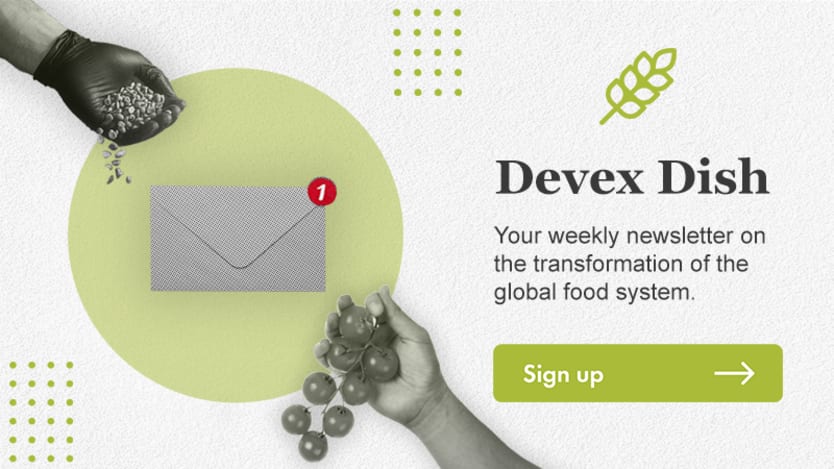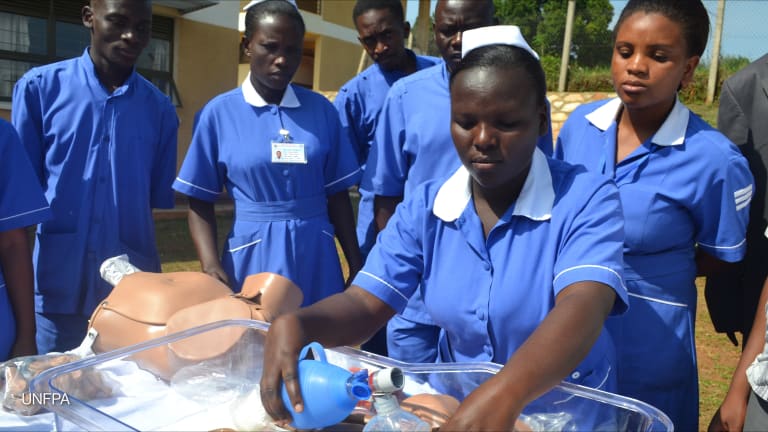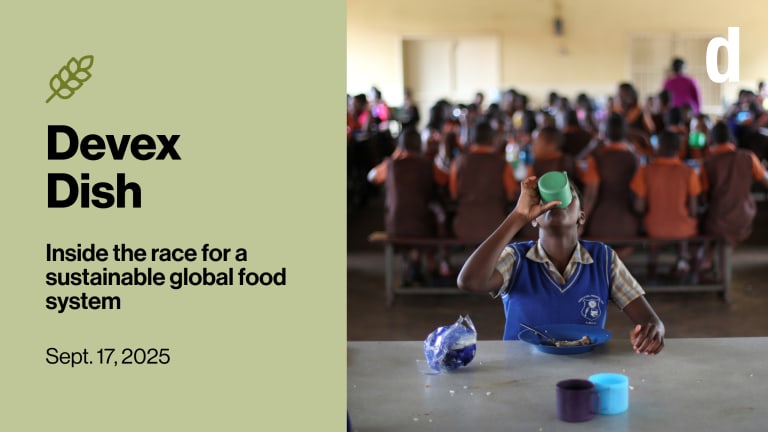
Financing for severe acute malnutrition has long been relegated to humanitarian budgets — even though the countries with the highest prevalence of wasting are often not experiencing humanitarian emergencies. A new UNICEF fund aims to change the way ready-to-use-therapeutic foods, or RUTFs, are financed by incentivizing countries to spend more out of their own budgets on malnutrition commodities.
In partnership with the Children’s Investment Fund Foundation and Gates Foundation, along with seed money from the U.K., the Nutrition Match Fund provides dollar-for-dollar matches for governments that include purchases of RUTFs in their national budgets and plans. Four countries — Mauritania, Senegal, Nigeria, and Uganda — have already taken advantage of the mechanism, raising $4 million between them.
This is a preview of Devex Dish
Sign up to this newsletter to get the inside track on how agriculture, nutrition, sustainability, and more are intersecting to remake the global food system in this weekly newsletter.
“If they give us $100 to procure RUTFs, we’ll give them $200 worth of RUTFs. That’s where the match occurs, in our procurement process,” Saul Guerrero, senior adviser for emergency nutrition at UNICEF, tells me.
Reducing wasting is more important than ever: UNICEF projects that an additional 9 million children will suffer from the disease due to COVID-19 pandemic, climate change, conflict, and ongoing inequality projects.
The people I spoke with weren’t aware of any other efforts to use a matching fund to leverage spending on malnutrition commodities in this way, but it’s the type of innovative financing last year’s Nutrition for Growth Summit called for to increase overall spending on nutrition. I’ll be tracking the effort to see how successful it is, and whether measurable decreases in SAM will be attained.
What do you think? Will the Nutrition Match Fund help incentivize national spending and reduce levels of malnutrition? What other innovative financing mechanisms deserve attention? Write to me with your thoughts at dish@devex.com.
Malnutrition: How a UNICEF match fund aims to catalyze domestic resources
Number munching
140.7 points
—That was the average of FAO’s Food Price Index, which measures changes in the international prices of a basket of food commodities, in February — an all time high. And as an average for the entire month, that figure only reflects some of the initial effects of Russia’s ongoing invasion of Ukraine, which began Feb. 24. The U.N. agency’s index was up 20.7% from a year ago, with prices for cereals (such as wheat and maize) up 14.8%.
In addition to the index for February, FAO has just released the first “Crop Prospects and Food Situation” report of 2022. It is published quarterly and goes into much more detail — really, a lot of detail! — about what can be expected for yields and prices of key staple foods over the coming year.
But, as the report also notes, much of the analysis was also completed before the Russian invasion, so it does not incorporate the full scale of the war into its forecasts. This is something I’ll be continuing to watch closely, as it could impact other food-insecure areas of the world. I’ll also have my eye on any outcomes from Friday’s G-7 agriculture ministers’ discussions on how the crisis will impact food security.
Land grab
The Tanzanian government is attempting to evict the Masai people and their herds of livestock from the Ngorongoro district in the northern part of the country. The government is trying to clear the pastoralists from a previously designated conservation area to make room for an Emirati company’s tourism project that includes trophy hunting. Over 70,000 people could be displaced from a 1,500 square kilometer (580 square mile) portion of the area, despite it being a UNESCO World Heritage Site.
“We are not stakeholders in conservation. Conservation for us is not an initiative; it is a way of life,” said Samwel Nangiria, a resident of the area.
The community is fighting back, as it considers taking the case to the African Commission on Human and Peoples' Rights. An independent think tank has also approached the U.N. for potential options to stop the land seizure.
Read: Tanzania's Masai fight eviction from UNESCO World Heritage Site
Household spending
We celebrated International Women’s Day on Tuesday — and to mark the occasion, my colleague Miguel Antonio Tamonan dug into the Gates Foundation’s spending on women’s empowerment.
We know that women are often the ones making nutritional decisions for their households, and Miguel found that food and nutrition are among the specific areas that the foundation is funding through its grants. Devex Pro subscribers can read the full analysis of the foundation’s spending.
+ Pro subscribers can catch up on the Gates Foundation’s top 10 agriculture grant winners. Not gone Pro yet? Start your 15-day free trial today.
A mouthful
“Agrifood system investments are an investment in poverty reduction and long-term economic development, and so we shouldn’t bypass them in order to build back better.”
— James Thurlow, senior research fellow, International Food Policy Research InstituteAs the death toll from COVID-19 passes 6 million people and we come up on two full years of the pandemic, Thurlow argued during a press briefing that some pandemic recovery efforts have been misguided, focusing too heavily on urban areas and large businesses rather than rural areas and farms. In a report released this week from IFPRI, researchers including Thurlow examine what we’ve learned about food security from the pandemic and what still needs to be done to ensure food systems are resilient to future shocks.
Bringing home the bacon: Your next job?
Gender Agricultural Livelihoods Analyst
Adam Smith International
Timor-Leste
Chew on this
Adaptations to climate change must be scaled to avoid the worst impacts on food security, writes Eric Schwaab of the Environmental Defense Fund. [The Hill]
With food insecurity rising, Africa’s nascent insect farming industry is taking off. [The Guardian]
Changes in global temperatures and weather patterns due to climate change may negatively affect food safety by increasing aflatoxins and other contaminants. [FAO]









